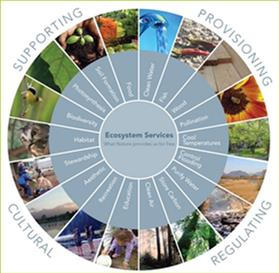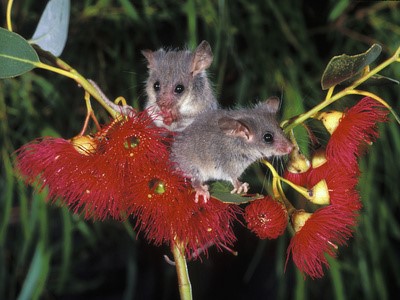Download PDF: ISPL July 2017 – Ecosystems Services – Key Concepts
In recent years, there has been a growing understanding and interest in ecosystem services by Governments, communities and land managers. But, what exactly are ecosystems services? How do we measure or monitor them? And should we consider ecosystem services in our approach to managing environmental issues for development projects?
These are just some of the questions I hope to provide an answer to across a series of short blogs.
What is an Ecosystem?
 To understand ecosystem services, we first need to understand what an ecosystem is and how it works.
To understand ecosystem services, we first need to understand what an ecosystem is and how it works.
An ecosystem refers to the biotic components within a given area – the plants, animals and organisms, which interact with abiotic components – the sun, air, nutrients, soil, water.
These complex interactions and relationships between living and non-living components in natural areas help to support and maintain the ecosystem and its function.
What are Ecosystem Services?
Natural ecosystems provide a range of benefits to people and communities through the transformation of resources into essential goods and services. These goods and services are vital for human life and sustain our livelihoods.
Four types of ecosystem services can be identified:
- Provisioning
This includes services such as food, nutrients and clean, fresh water
- Regulating
This includes services like flood and disease control, pollination, climate regulation, water purification, seed dispersal and erosion regulation
- Supporting
This includes services such as nutrient cycling, water cycles that maintain conditions for life on Earth, carbon cycles, breakdown of organic matter
- Cultural
This includes the spiritual, recreational, cultural, education and amenity services
What Ecosystems Provide Services?
Ecosystem services occur or are provided in healthy ecosystems and are part of the functions which arise from the complex interactions between biotic and abiotic components.
 Ecosystem services can be maintained in modified landscapes however, over extended periods of time, the potential for degraded or modified ecosystems to continue to provide these ecosystem services is limited. Especially when ecological thresholds are crossed and the degraded ecosystem is no longer capable of providing these services.
Ecosystem services can be maintained in modified landscapes however, over extended periods of time, the potential for degraded or modified ecosystems to continue to provide these ecosystem services is limited. Especially when ecological thresholds are crossed and the degraded ecosystem is no longer capable of providing these services.
Many ecosystem services are not easy to identify or observe until they cease to occur. Often when this occurs the effects of their loss become apparent to communities and land managers prompting examination to understand and restore the degraded ecosystem.
In essence this means to maintain human life we need healthy ecosystems.
The Value of Ecosystem Services
It is almost impossible to put a monetary value or price on ecosystem services particularly when you consider that these services are vital for human life. However, ecosystem services can be thought of as ‘natural capital’ or the living and non-living components of an ecosystem that contribute to the generation of goods and services.
 The full cost of the ecosystem service is often not considered or included in a market price even though the good or service is directly or indirectly a result of an ecosystem service. When ecosystem services are regarded as ‘free’ there is no incentive to protect the ecosystem or the role / use of the service. This undervaluing of ecosystem services leads to unsustainable resource use and environmental degradation (also known as the tragedy of the commons but that is another discussion!).
The full cost of the ecosystem service is often not considered or included in a market price even though the good or service is directly or indirectly a result of an ecosystem service. When ecosystem services are regarded as ‘free’ there is no incentive to protect the ecosystem or the role / use of the service. This undervaluing of ecosystem services leads to unsustainable resource use and environmental degradation (also known as the tragedy of the commons but that is another discussion!).
Determining a price or market value on ecosystem services provides a way for people to understand the benefits which flow from healthy ecosystems and the value in protecting these ecosystems for future generations.

